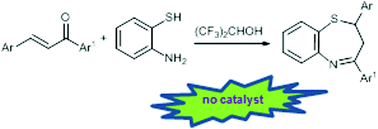
Catalysis in alternative solvents
p-TSA-Based DESs as “Active Green Solvents” for Microwave Enhanced Cyclization of 2-Alkynyl-(hetero)-arylcarboxylates: an Alternative Access to 6-Substituted 3,4-Fused 2-Pyranones[Link]
F. Curti, M. Tiecco, V. Pirovano, R. Germani, A. Caselli, E. Rossi, G. Abbiati Eur. J. Inorg. Chem., 2019, 1904-1914
Abstract
In this paper, we describe the use of p-TSA based Deep Eutectic Solvents (DESs) as alternative environmental-friendly “active” solvents for the microwave-mediated synthesis of 6-substituted
3,4-fused 2-pyranones, and in particular isocoumarins, starting from 2-alkynyl-(hetero)arylcarboxylates. When the alkyne terminus bears a neutral or an electron-donating group (EDG), the reactions are
fast, clean and highly regioselective, to give the 6-endo-dig cyclization products in good to excellent yields. For substrates bearing an electron-withdrawing group (EWG) on the alkyne end, the
regioselectivity can be tuned by adding a small amount of silver(I) triflate as co-catalyst. DES was demonstrated to be reusable without loss of efficiency in terms of reaction yields. Based on
experimental evidence and previous findings, two competitive mechanisms working simultaneously are proposed to explain the outcomes and the regioselectivity issues.

Organocatalytic Michael addition to (D)-mannitol-derived enantiopure nitroalkenes: a valuable strategy for the synthesis of densely functionalized chiral molecules.[Link]
L. Caruso, A. Puglisi, E. Gillon, M. Benaglia, molecules, 2019, 24, 4588-4597
Abstract
(D)-mannitol was selected as valuable platform, directly available from the chiral pool, to build highly functionalized
molecules. Starting from (R)-2,3-O-cyclohexylidene glyceraldehyde, easily prepared on large scale from D-mannitol, an
enantiopure chiral nitro alkene was prepared, by reaction with nitromethane, and its reactivity studied. Organocatalytic
Michael addition of dimethyl malonate, β-keto esters and other nucleophiles on the nitro alkene afforded with high
stereoselectivity densely functionalised chiral molecules, which were further synthetically elaborated, leading to five-membered
lactones and bicyclic lactams. Preliminary studies showed that the metal-free catalytic reaction on the chiral nitro alkene can
be performed also under continuous flow conditions, thus opening the way to the use of (micro)meso fluidic systems for the
preparation of enantiomerically pure organic molecules from the chiral pool.

A practical synthesis of 2,3-dihydro-1,5-benzothiazepines[Link]
N. Gaggero, D.C.M. Albanese M. Fei Green Chemistry, 2017, 19, 5703-5707.
Abstract
2,3-Dihydro-1,5-benzothiazepines have been obtained through a domino process involving a Michael addition of 2-aminothiophenols
to chalcones, followed by in situ cyclization. Up to 98% chemical yields have been obtained at room temperature under essentially
neutral conditions by using hexafluoro-2-propanol as an efficient medium.

Stereoselective organocatalysed reactions in deep eutectic solvents: highly tunable and biorenewable reaction media for sustainable Organic synthesis.
E. Massolo, S. Palmieri, M. Benaglia, V. Capriati, F. M. Pernab Green Chem., 2015. [Link]
Abstract:
Three distinct stereoselective reactions, catalysed by using a chiral primary amine through different activation methods,
have been successfully carried out for the first time in bio-based eutectic mixtures, thereby affording functionalised
molecules in very high enantioselectivity. The use of these unconventional and biorenewable reaction media also provides
opportunities for facilitating the recovery and the recycling of the chiral catalyst.
